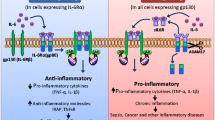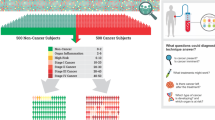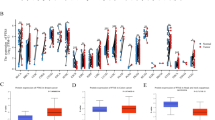Abstract
Background
This study assessed programmed cell death ligand 1 (PD-L1) expression in primary tissues and soluble PD-L1 (sPD-L1) concentration in matched preoperative serum in gastric cancer (GC) patients to perform direct comparison between tissue and serum PD-L1 expression and to clarify the prognostic implication in GC.
Methods
The study enrolled 180 GC patients who underwent surgery for GC at the authors’ institution. The study evaluated tissue PD-L1 expression using immunohistochemistry and quantified sPD-L1 concentration in preoperative serum using enzyme-linked immunosorbent assay in GC patients.
Results
The findings showed that PD-L1 was overexpressed in GC tissues compared with normal mucosa. Tissue PD-L1 expression was significantly higher in the GC patients with advanced T stage, presence of lympho-vascular invasion, lymph node metastasis, and peritoneal metastasis. Furthermore, elevated tissue PD-L1 expression was significantly associated with poor prognosis for overall survival (OS) and disease-free survival (DFS). Serum sPD-L1 was significantly higher in the GC patients than in the healthy volunteers. Although serum sPD-L1 was not correlated with any clinicopathologic factors, the patients with high serum sPD-L1 showed poorer OS and DFS than those with low sPD-L1. Multivariate analyses showed that both elevated tissue PD-L1 and serum sPD-L1 were independent prognostic factors for poor OS [tissue PD-L1: hazard ratio (HR), 4.28; 95% confidence interval (CI), 1.43–12.8; P = 0.0094 vs. serum sPD-L1: HR, 11.2; 95% CI, 3.44–36.7; P = 0.0001] and poor DFS (tissue PD-L1: HR, 6.96; 95% CI, 2.48–19.6; P = 0.0002 vs. serum sPD-L1: HR, 8.7; 95% CI, 3.16–23.9; P < 0.0001) for the GC patients. Furthermore, infiltrative CD8- and Foxp3-positive T cells were significantly increased in the GC patients with elevated tissue PD-L1 expression.
Conclusion
Both serum sPD-L1 and tissue PD-L1 expression may serve as predictive biomarkers for recurrence and prognosis in GC patients.

Similar content being viewed by others
References
Kashihara H, Shimada M, Yoshikawa K, et al. Risk factors for recurrence of gastric cancer after curative laparoscopic gastrectomy. J Med Investig. 2017;64:79–84.
Marano L, Polom K, Patriti A, et al. Surgical management of advanced gastric cancer: an evolving issue. Eur J Surg Oncol. 2016;42:18–27.
Siegel RL, Miller KD, Jemal A. Cancer Statistics, 2017. CA Cancer J Clin. 2017;67:7–30.
Vennin C, Murphy KJ, Morton JP, Cox TR, Pajic M, Timpson P. Reshaping the tumor stroma for treatment of pancreatic cancer. Gastroenterology. 2018;154:820–38.
Bertucci F, Finetti P, Perrot D, et al. PDL1 expression is a poor-prognosis factor in soft-tissue sarcomas. Oncoimmunology. 2017;6:e1278100.
Schreiber RD, Old LJ, Smyth MJ. Cancer immunoediting: integrating immunity’s roles in cancer suppression and promotion. Science. 2011;331:1565–70.
Vesely MD, Kershaw MH, Schreiber RD, Smyth MJ. Natural innate and adaptive immunity to cancer. Annu Rev Immunol. 2011;29:235–71.
Jiang X, Shapiro DJ. The immune system and inflammation in breast cancer. Mol Cell Endocrinol. 2014;382:673–82.
Bertucci F, Finetti P, Mamessier E, et al. PDL1 expression is an independent prognostic factor in localized GIST. Oncoimmunology. 2015;4:e1002729.
Hanahan D, Weinberg RA. Hallmarks of cancer: the next generation. Cell. 2011;144:646–74.
Schachter J, Ribas A, Long GV, et al. Pembrolizumab versus ipilimumab for advanced melanoma: final overall survival results of a multicentre, randomised, open-label phase 3 study (KEYNOTE-006). Lancet. 2017;390:1853–62.
Garon EB, Rizvi NA, Hui R, et al. Pembrolizumab for the treatment of non-small cell lung cancer. N Engl J Med. 2015;372:2018–28.
Kang YK, Boku N, Satoh T, et al. Nivolumab in patients with advanced gastric or gastro-oesophageal junction cancer refractory to, or intolerant of, at least two previous chemotherapy regimens (ONO-4538-12, ATTRACTION-2): a randomised, double-blind, placebo-controlled, phase 3 trial. Lancet. 2017;390:2461–71.
Pardoll DM. The blockade of immune checkpoints in cancer immunotherapy. Nat Rev Cancer. 2012;12:252–64.
Afreen S, Dermime S. The immunoinhibitory B7-H1 molecule as a potential target in cancer: killing many birds with one stone. Hematol Oncol Stem Cell Ther. 2014;7:1–17.
Blank C, Gajewski TF, Mackensen A. Interaction of PD-L1 on tumor cells with PD-1 on tumor-specific T cells as a mechanism of immune evasion: implications for tumor immunotherapy. Cancer Immunol Immunother. 2005;54:307–14.
Keir ME, Butte MJ, Freeman GJ, Sharpe AH. PD-1 and its ligands in tolerance and immunity. Annu Rev Immunol. 2008;26:677–704.
Nomi T, Sho M, Akahori T, et al. Clinical significance and therapeutic potential of the programmed death-1 ligand/programmed death-1 pathway in human pancreatic cancer. Clin Cancer Res. 2007;13:2151–7.
Kim JW, Nam KH, Ahn SH, et al. Prognostic implications of immunosuppressive protein expression in tumors as well as immune cell infiltration within the tumor microenvironment in gastric cancer. Gastric Cancer. 2016;19:42–52.
Velcheti V, Schalper KA, Carvajal DE, et al. Programmed death ligand-1 expression in non-small cell lung cancer. Lab Invest. 2014;94:107–16.
Boland JM, Kwon ED, Harrington SM, et al. Tumor B7-H1 and B7-H3 expression in squamous cell carcinoma of the lung. Clin Lung Cancer. 2013;14:157–63.
Spranger S, Spaapen RM, Zha Y, et al. Up-regulation of PD-L1, IDO, and T(regs) in the melanoma tumor microenvironment is driven by CD8(+) T cells. Sci Translat Med. 2013;5:200ra116.
Thompson RH, Gillett MD, Cheville JC, et al. Costimulatory molecule B7-H1 in primary and metastatic clear cell renal cell carcinoma. Cancer. 2005;104:2084–91.
Chen Y, Wang Q, Shi B, et al. Development of a sandwich ELISA for evaluating soluble PD-L1 (CD274) in human sera of different ages as well as supernatants of PD-L1 + cell lines. Cytokine. 2011;56:231–8.
Rossille D, Gressier M, Damotte D, et al. High level of soluble programmed cell death ligand 1 in blood impacts overall survival in aggressive diffuse large B-Cell lymphoma: results from a French multicenter clinical trial. Leukemia. 2014;28:2367–75.
Wang L, Wang H, Chen H, et al. Serum levels of soluble programmed death ligand 1 predict treatment response and progression free survival in multiple myeloma. Oncotarget. 2015;6:41228–36.
Mori K, Toiyama Y, Saigusa S, et al. Systemic analysis of predictive biomarkers for recurrence in colorectal cancer patients treated with curative surgery. Dig Dis Sci. 2015;60:2477–87.
Ha H, Nam AR, Bang JH, et al. Soluble programmed death-ligand 1 (sPDL1) and neutrophil-to-lymphocyte ratio (NLR) predicts survival in advanced biliary tract cancer patients treated with palliative chemotherapy. Oncotarget. 2016;7:76604–12.
Lin G, Fan X, Zhu W, et al. Prognostic significance of PD-L1 expression and tumor infiltrating lymphocyte in surgically resectable non-small cell lung cancer. Oncotarget. 2017;8:83986–94.
Ceeraz S, Nowak EC, Noelle RJ. B7 family checkpoint regulators in immune regulation and disease. Trends Immunol. 2013;34:556–63.
Riley JL. PD-1 signaling in primary T cells. Immunol Rev. 2009;229:114–25.
Francisco LM, Salinas VH, Brown KE, et al. PD-L1 regulates the development, maintenance, and function of induced regulatory T cells. J Exper Med. 2009;206:3015–29.
He J, Hu Y, Hu M, Li B. Development of PD-1/PD-L1 pathway in tumor immune microenvironment and treatment for non-small cell lung cancer. Sci Rep. 2015;5:13110.
Frigola X, Inman BA, Lohse CM, et al. Identification of a soluble form of B7-H1 that retains immunosuppressive activity and is associated with aggressive renal cell carcinoma. Clin Cancer Res. 2011;17:1915–23.
Tamura T, Ohira M, Tanaka H, et al. Programmed death-1 ligand-1 (pdl1) expression is associated with the prognosis of patients with stage II/III gastric cancer. Anticancer Res. 2015;35:5369–76.
Zhang M, Dong Y, Liu H, et al. The clinicopathological and prognostic significance of PD-L1 expression in gastric cancer: a meta-analysis of 10 studies with 1901 patients. Sci Rep. 2016;6:37933.
Brody R, Zhang Y, Ballas M, et al. PD-L1 expression in advanced NSCLC: insights into risk stratification and treatment selection from a systematic literature review. Lung Cancer Amsterdam. 2017;112:200–15.
Wu P, Wu D, Li L, Chai Y, Huang J. PD-L1 and survival in solid tumors: a meta-analysis. PloS One. 2015;10:e0131403.
Ju X, Shen R, Huang P, et al. Predictive relevance of PD-L1 expression with pre-existing TILs in gastric cancer. Oncotarget. 2017;8:99372–81.
Amatatsu M, Arigami T, Uenosono Y, et al. PD-L1 is a promising blood marker for predicting tumor progression and prognosis in patients with gastric cancer. Cancer Sci. 2018;109:814–20.
Okazaki T, Maeda A, Nishimura H, Kurosaki T, Honjo T. PD-1 immunoreceptor inhibits B cell receptor-mediated signaling by recruiting SRC homology 2-domain-containing tyrosine phosphatase 2 to phosphotyrosine. Proc Natl Acad Sci USA. 2001;98:13866–71.
Acknowledgment
The authors thank Yuki Orito and Amphone Okada for their excellent technical assistance. They also thank the Edanz Group (www.edanzediting.com/ac) for editing a draft of this manuscript. A part of this study was supported by a Grant in Aid for Scientific Research (16K10533) from the Ministry of Education, Culture, Sports, Science, and Technology, Japan.
Author information
Authors and Affiliations
Contributions
Study concept and design (TS, YT, YO, TS, KM); provision of samples (TI, SI, HF, HY, JH, SY, MO, TA, MK); acquisition of data (TS, YO, AY, LY, AN, TS); analysis and interpretation of data (TS, YT, YO, HY, SY, MO); statistical analysis (TS, YT, YO); drafting the manuscript (TS, YT, YO, MK).
Corresponding authors
Ethics declarations
Disclosure
There are no conflicts of interest.
Additional information
Publisher's Note
Springer Nature remains neutral with regard to jurisdictional claims in published maps and institutional affiliations.
Electronic supplementary material
Below is the link to the electronic supplementary material.
Fig. S1
Scoring system for immunohistochemical analysis of programmed cell death ligand 1 (PD-L1) expression in gastric cancer (GC). a–d The intensity of PD-L1 staining was scored as (a) 0 (negative) (b) 1 (weak), (c) 2 (moderate), or (d) 3 (strong). e–h The extent of PD-L1 staining was scored as the percentage of cancer cells with cytoplasmic staining: 0 (0%), (e) 1 (1–25%), (f) 2 (25–50%), (g) 3 (51–75%), or (h) 4 (76–100%). Representative images are shown. All images were captured at a magnification of × 200. (TIF 6928 kb)
Fig. S2
Correlation between tissue programmed cell death ligand 1 (PD-L1) and serum soluble PD-L1 (sPD-L1) levels in gastric cancer (GC) patients. The preoperative serum sPD-1 showed a tendency toward elevation in the GC patients with high tissue PD-L1 expression versus those with low tissue PD-L1 expression. A significant correlation was not observed (P = 0.1). (TIF 493 kb)
Fig. S3
Immunohistochemical staining of CD8- and Foxp3- positive tumor-infiltrating lymphocytes (TILs). a CD8-positive TILs density in marginal part (original magnification × 400). b Intratumoral densities of CD8-positive stained cells in the marginal part measured using an automatic image analysis system (original magnification × 400). c Foxp3-positive TILs density in the marginal part (original magnification × 400). d Intratumoral densities of Foxp3-positive stained cells in the marginal part measured using an automatic image analysis system (original magnification × 400). (TIF 4008 kb)
Rights and permissions
About this article
Cite this article
Shigemori, T., Toiyama, Y., Okugawa, Y. et al. Soluble PD-L1 Expression in Circulation as a Predictive Marker for Recurrence and Prognosis in Gastric Cancer: Direct Comparison of the Clinical Burden Between Tissue and Serum PD-L1 Expression. Ann Surg Oncol 26, 876–883 (2019). https://doi.org/10.1245/s10434-018-07112-x
Received:
Published:
Issue Date:
DOI: https://doi.org/10.1245/s10434-018-07112-x




